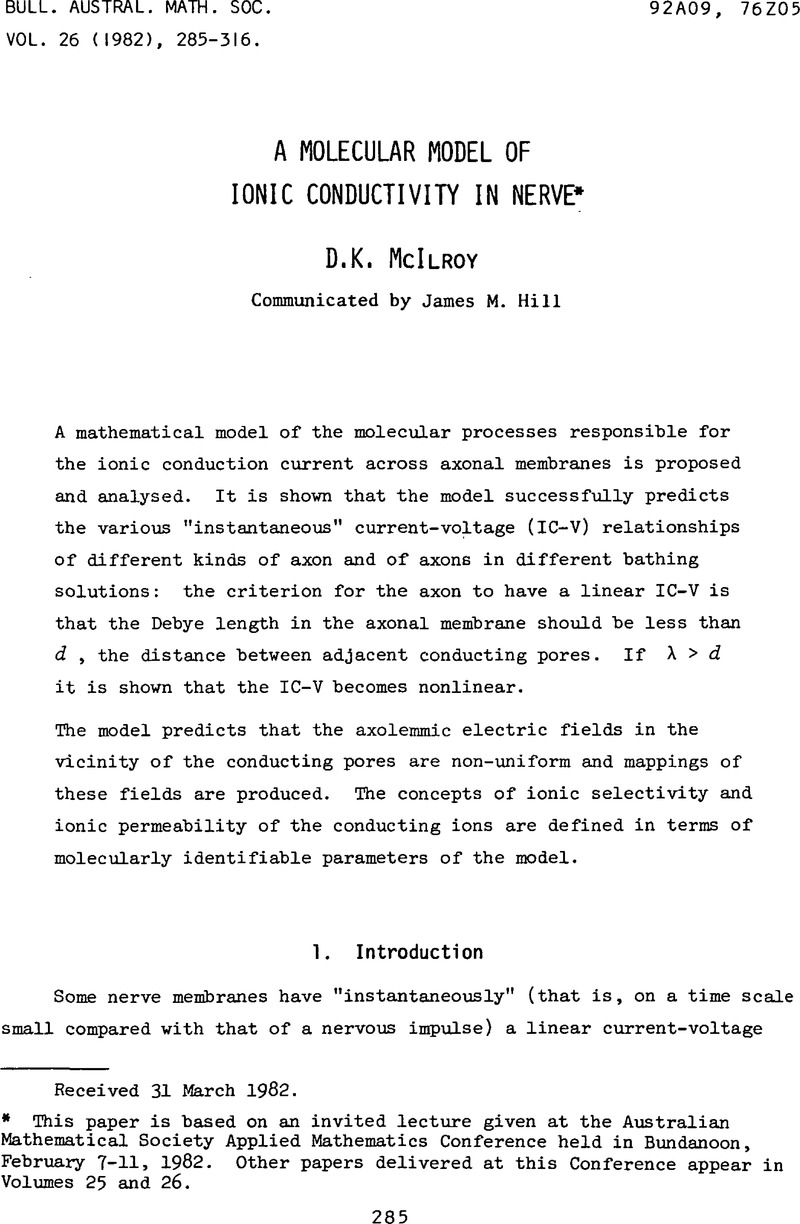No CrossRef data available.
Article contents
A molecular model of ionic conductivity in nerve*
Published online by Cambridge University Press: 17 April 2009
Abstract
An abstract is not available for this content so a preview has been provided. As you have access to this content, a full PDF is available via the ‘Save PDF’ action button.

- Type
- Australian Mathematical Societyt Applied Mathematics Conference
- Information
- Bulletin of the Australian Mathematical Society , Volume 26 , Issue 2 , October 1982 , pp. 285 - 316
- Copyright
- Copyright © Australian Mathematical Society 1982
References
[1]Brinley, F. Jr., “Discussion report: ‘Conference on newer properties perfused squid axons’”, J. Gen. Physiol. 48 (1965), no. 5, 41–47.Google Scholar
[2]Cole, Kenneth S., “Electrodiffusion models for the membrane of squid giant axon“, Physiol. Rev. 45 (1965), 340–379.CrossRefGoogle ScholarPubMed
[3]Cole, Kenneth S., Membrane, ions and impulses: A chapter of classical biophysics (Biophysics Series, 1. University of California Press, Berkeley and Los Angeles, 1968).CrossRefGoogle Scholar
[4]Chandler, W.K. and Meves, H., “Sodium inactivation in internally perfused squid giant axons”, Arch. Ges. Physiol. 281 (1964), 25–26.Google Scholar
[5]Goldman, David E., “Potential, impedance, and rectification in membranes”, J. Gen. Physiol. 27 (1944), 37–60.CrossRefGoogle Scholar
[6]Hillie, Bertil, “Pharmacological modifications of the sodium channels of frog nerve”, J. Gen. Physiol. 51 (1968), 199–220.CrossRefGoogle Scholar
[7]Hille, Bertil, “The permeability of sodium channels to organic cations in myelinated nerve”, J. Gen. Physiol. 58 (1971), 599–619.CrossRefGoogle ScholarPubMed
[8]Hillie, BertiI, “Ionic channels in excitable membranes: current problems and biophysical approaches”, Biophys. J. 22 (1978), 283–294.CrossRefGoogle Scholar
[9]Hodgkin, A.L., The conduction of the nervous impulse (The Sherrington Lectures, 7. Liverpool University Press, Liverpool, 1964).Google Scholar
[10]Hodgkin, A.L. and Chandler, W.K., “Effects of changes in ionic strength on inactivation and threshold in perfused nerve fibres of Loligo”, J. Gen. Physiol. 48 (1965), no. 5, 27–30.CrossRefGoogle ScholarPubMed
[11]Hodgkin, A.L. and Huxley, A.F., “The components of membrane conductance in the giant axon of Loligo”, J. Physiol. 116 (1952), 473–496.CrossRefGoogle ScholarPubMed
[12]Hodgkin, A.L. and Huxley, A.F., “A quantitative description of membrane current and its application to conduction and excitation in nerve”, J. Physiol. 117 (1952), 500–544.CrossRefGoogle ScholarPubMed
[13]Katz, Bernard, Nerve, muscle, and synapse (McGraw-Hill, New York, San Francisco, Sydney, 1966).Google Scholar
[14]Mcllroy, Douglas Kenneth, “A mathematical model of the nerve impulse at the molecular level”, Math. Biosci. 7 (1970), 313–328.CrossRefGoogle Scholar
[15]MelIroy, Douglas Kenneth, “Analysis of the enzyme model of the nerve”, Math. Biosci. 8 (1970), 109–129.Google Scholar
[16]Mcllroy, D.K. and Mason, D.P., “Electric field dissociation of charged macromolecular sites in polarized biomembranes: III. Numerical results and application to nervous conduction”, SIAM J. Appl. Math. 41 (1981), 580–591.CrossRefGoogle Scholar
[17]Nafahashl, T., “Dependence of resting and action potentials on internal potassium in perfused squid giant axons”, J. Physiol. 169 (1963), 91–115.Google Scholar
[18]Planck, M., “Ueber die Erregung von Elektricät und Wärme in Elektrolyten”, Wiedemann Ann. 39 (1890), 161–186.CrossRefGoogle Scholar
[19]Tasaki, Ichiji, “Permeability of squid axon membrane to various ions”, J. Gen. Physiol. 46 (1963), 755–772.CrossRefGoogle ScholarPubMed




